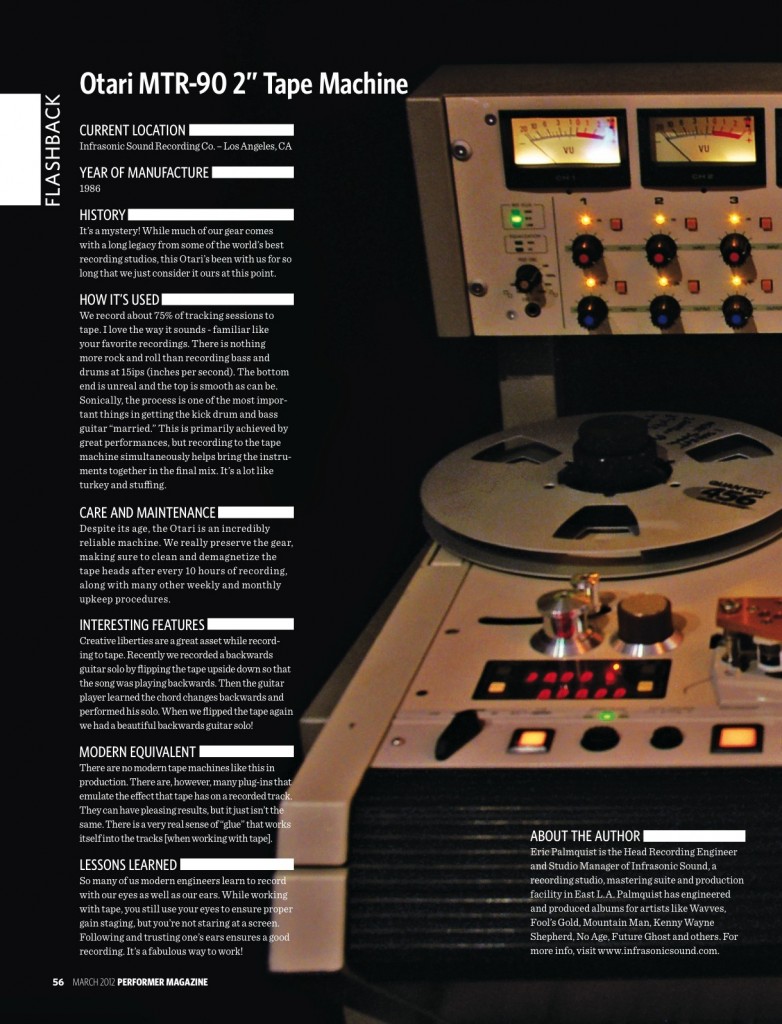 Thanks to Eric Palmquist and
Thanks to Eric Palmquist and  Infrasonic in Los Angeles for this month’s gear flashback – an Otari 2-inch tape machine. We think this is an absolutely beautiful machine, and agree that modern-day engineers can learn a thing or two from cutting tracks on tape.
Infrasonic in Los Angeles for this month’s gear flashback – an Otari 2-inch tape machine. We think this is an absolutely beautiful machine, and agree that modern-day engineers can learn a thing or two from cutting tracks on tape.
Current Location: Infrasonic Sound Recording Co. – Los Angeles, CA
Year of Manufacture: 1986
History: It’s a mystery! While much of our gear comes with a long legacy from some of the world’s best recording studios, this Otari’s been with us for so long that we just consider it ours at this point.
How It’s Used: We record about 75% of tracking sessions to tape. I love the way it sounds – familiar like your favorite recordings. There is nothing more rock and roll than recording bass and drums at 15ips (inches per second). The bottom end is unreal and the top is smooth as can be. Sonically, the process is one of the most important things in getting the kick drum and bass guitar “married.” This is primarily achieved by great performances, but recording to the tape machine simultaneously helps bring the instruments together in the final mix. It’s a lot like turkey and stuffing.
Care and Maintenance: Despite its age, the Otari is an incredibly reliable machine. We really preserve the gear, making sure to clean and demagnetize the tape heads after every 10 hours of recording, along with many other weekly and monthly upkeep procedures.
Interesting Features: Creative liberties are a great asset while recording to tape. Recently we recorded a backwards guitar solo by flipping the tape upside down so that the song was playing backwards. Then the guitar player learned the chord changes backwards and performed his solo. When we flipped the tape again we had a beautiful backwards guitar solo!
Modern Equivalent: There are no modern tape machines like this in production. There are, however, many plug-ins that emulate the effect that tape has on a recorded track. They can have pleasing results, but it just isn’t the same. There is a very real sense of “glue” that works itself into the tracks [when working with tape].
What Can Modern Engineers Learn From This Piece? So many of us modern engineers learn to record with our eyes as well as our ears. While working with tape, you still use your eyes to ensure proper gain staging, but you’re not staring at a screen. Following and trusting one’s ears ensures a good recording. It’s a fabulous way to work!
Other Notes: Here at Infrasonic, we’re able to combine the best of both analog and modern techniques with a piece of gear called the CLASP, which integrates analog tape recorders with DAWs. This saves bands time and money, but also preserves that larger than life sound you can only achieve when tracking to tape. It’s a nice alternative for a band on a budget.
Eric Palmquist is the Head Recording Engineer and Studio Manager of Infrasonic Sound, a recording studio, mastering suite and production facility in East L.A. Palmquist has engineered and produced albums for artists like Wavves, Fool’s Gold, Mountain Man, Kenny Wayne Shepherd, No Age, Future Ghost and others. For more info, visit www.infrasonicsound.com.
